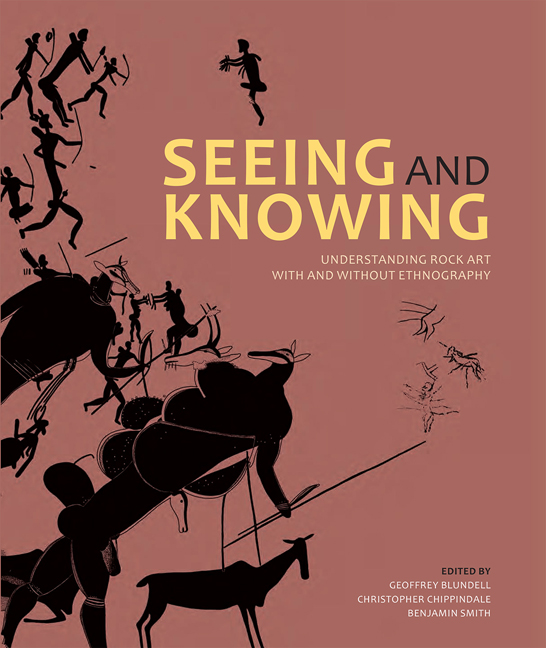Book contents
- Frontmatter
- Dedication
- Contents
- Contributors
- Acronyms
- Chapter 1 Rock art with and without ethnography
- Chapter 2 Flashes of brilliance: San rock paintings of heaven's things
- Chapter 3 Snake and veil: The rock engravings of Driekopseiland, Northern Cape South Africa
- Chapter 4 Cups and saucers: A preliminary investigation of the rock carvings of Tsodilo Hills, northern Botswana
- Chapter 5 Art and authorship in southern African rock art: Examining the Limpopo-Shashe Confluence Area
- Chapter 6 Archaeology, ethnography, and rock art: A modern-day study from Tanzania
- Chapter 7 Art and belief: The ever-changing and the never-changing in the Far west
- Chapter 8 Crow Indian elk love-medicine and rock art in Montana and Wyoming
- Chapter 9 Layer by layer: Precision and accuracy in rock art recording and dating
- Chapter 10 From the tyranny of the figures to the interrelationship between myths, rock art and their surfaces
- Chapter 11 Composite creatures in European Palaeolithic art
- Chapter 12 Thinking strings: On theory, shifts and conceptual issues in the study of Palaeolithic art
- Chapter 13 Rock art without ethnography? A history of attitude to rock art and landscape at Frøysjøen, western norway
- Chapter 14 ‘Meaning cannot rest or stay the same’
- Chapter 15 Manica rock art in contemporary society
- Chapter 16 Oral tradition, ethnography, and the practice of north American archaeology
- Chapter 17 Beyond rock art: Archaeological interpretation and the shamanic frame
- List of figures
- List of tables
- List of publications by david Lewis-williams
- Index
Chapter 16 - Oral tradition, ethnography, and the practice of north American archaeology
Published online by Cambridge University Press: 21 April 2018
- Frontmatter
- Dedication
- Contents
- Contributors
- Acronyms
- Chapter 1 Rock art with and without ethnography
- Chapter 2 Flashes of brilliance: San rock paintings of heaven's things
- Chapter 3 Snake and veil: The rock engravings of Driekopseiland, Northern Cape South Africa
- Chapter 4 Cups and saucers: A preliminary investigation of the rock carvings of Tsodilo Hills, northern Botswana
- Chapter 5 Art and authorship in southern African rock art: Examining the Limpopo-Shashe Confluence Area
- Chapter 6 Archaeology, ethnography, and rock art: A modern-day study from Tanzania
- Chapter 7 Art and belief: The ever-changing and the never-changing in the Far west
- Chapter 8 Crow Indian elk love-medicine and rock art in Montana and Wyoming
- Chapter 9 Layer by layer: Precision and accuracy in rock art recording and dating
- Chapter 10 From the tyranny of the figures to the interrelationship between myths, rock art and their surfaces
- Chapter 11 Composite creatures in European Palaeolithic art
- Chapter 12 Thinking strings: On theory, shifts and conceptual issues in the study of Palaeolithic art
- Chapter 13 Rock art without ethnography? A history of attitude to rock art and landscape at Frøysjøen, western norway
- Chapter 14 ‘Meaning cannot rest or stay the same’
- Chapter 15 Manica rock art in contemporary society
- Chapter 16 Oral tradition, ethnography, and the practice of north American archaeology
- Chapter 17 Beyond rock art: Archaeological interpretation and the shamanic frame
- List of figures
- List of tables
- List of publications by david Lewis-williams
- Index
Summary
THE CHANGING SHAPE OF NORTH AMERICAN ARCHAEOLOGY
Over the course of the last half of the 20th century, North American anthropology and archaeology have witnessed many changes, not the least of which has been the divergence of the sub-disciplines as most dramatically exemplified by the organisational split between the Society for American Archaeology and the American Anthropological Association in the mid- 1980s. Many academic departments have moved away from the traditional four-fields approach, with little to no crossover between sub-disciplines at the graduate level and specialisation within sub-disciplines for undergraduates. With increased specialisation, it has been many years since archaeologist and ethnographer have been the same individual, in the fashion of Frederica de Laguna (1960) in south-east Alaska. As a result, studies which explicitly seek to integrate oral tradition, ethnographic and archaeological data are extremely rare.
Specialisation has also been the dominating trend within North American archaeology. With the rise of the cultural ecological paradigm in the 1960s, many archaeologists began to employ a multidisciplinary approach, particularly with respect to natural sciences such as biology, plant and animal ecology, palynology, geology, chemistry and physics, giving rise to the technical specialist. As a result, many academic departments now offer tracks to train geo-archaeologists, ethnobotanists, faunal analysts, lithic analysts, or specialists in quantitative methods. It is notable that, with our roots in anthropology, the outside discipline that was left out was often cultural anthropology.
With the ‘New Archaeology’ of the 1960s and the goal to go beyond the reconstruction of culture history to the explanation of culture change (e.g. Fritz & Plog 1970), we archaeologists also desired to be viewed as ‘scientists’. We wished to use the scientific method to conduct experiments, to develop multiple working hypotheses and test them in a deductive manner, and to employ logical positivism (Hempel 1966) in a manner analogous to that of the natural sciences in order to discover laws governing human behaviour. We adopted the trappings of science in an effort to distance ourselves from the humanities.
- Type
- Chapter
- Information
- Seeing and KnowingUnderstanding Rock Art With and Without Ethnography, pp. 268 - 279Publisher: Wits University PressPrint publication year: 2010



